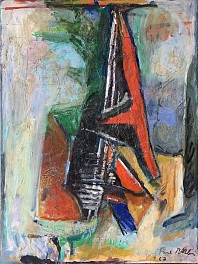BIOGRAPHY

American, 1886-1969
Paul Burlin had a long and successful career of eight decades, though his work did not turn to abstract expressionism--the style of this work and the style in which, arguably, his best work was produced--until the painter was in his seventies, a clear example of his stalwart, and lifelong pursuit of new forms of expression. He was the youngest to participate in the landmark Armory Show of 1913, showing alongside Monet, Picasso, Manet, and Degas, among others.
Like many other modernists of his time, Burlin was fascinated by “primitive” art. While still in New York, Burlin was profoundly affected by the African tribal art that he saw at the American Museum of Natural History in New York, as well as the Marius de Zaya collection of African sculpture. His frequent visits to Stieglitz’s gallery ‘291’ also exposed him to Picasso’s ‘primitive’ work.
Burlin moved to Santa Fe in 1913. Almost immediately, he became influenced, emotionally and intellectually, by the spirituality of the Southwestern Indian cultures, which inspired a preoccupation with symbols and myth that remained with him throughout his career.
For much of his life, Burlin felt a profound ambivalence about American art, admiring its vitality, energy, and freedom from the ‘aesthetic baggage’ of European art, while remaining wary of what he considered its crudeness and ignorance of the past. In 1921, he and his wife moved to Paris as part of an exodus of expatriate artists in response to what many felt was a hostile response to modernist art in the U.S. In Paris, Burlin arrived at the geographical locus of modern art. He studied European abstract artists, working with the Cubist Albert Gleizes, and further developed some of the intellectual and symbolic elements that he had begun in the Southwest. He would return to the U.S. in 1932.
Throughout the 1940s, Burlin’s work became less dependent on subject matter and more and more preoccupied with the expressive possibilities of shape and color. Burlin’s paintings from the last decades of his life are filled with energy and movement, restlessness and cacophony, balanced with technical mastery and clarity of vision. They exhibit Burlin’s unique combination of the symbols and spiritual themes that he discovered in the Southwest with the artistic style developed through his time in Europe. In these works, ‘the world of natural appearances [is] completely swallowed up in the vehemence of the painting,' said one critic.
Burlin exhibited throughout his career, including the 1930 ‘Painting and Sculpture by Living Americans’ exhibition and the 1944 ‘Art in Progress’ show, both at New York’s Museum of Modern Art. His work is included in numerous museum collections, including the Whitney Museum, which has 13 of his works.
